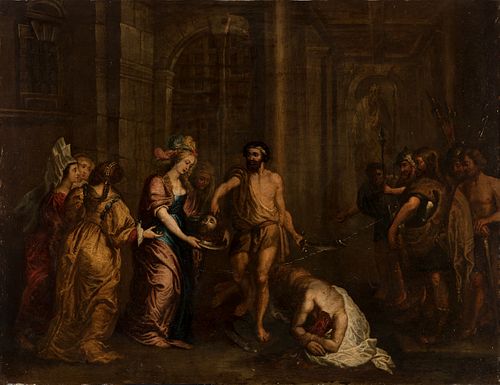Flemish school; first half of the 18th century. "Martyrdom of St. John the Baptist". Oil on copper.
Lot 37
About Seller
Setdart Auction House
Carrer Aragó 346
Barcelona
Spain
Setdart Subastas was born in 2004 and is currently the first online art auction in Spain with solidity, prestige and reliability guaranteed by our more than 60,000 users. Setdart has a young, dynamic and enterprising team ready to successfully manage the purchase and sale of art works through custom...Read more
Estimate:
EUR€2,000 - EUR€2,500
$2,150.54 - $2,688.17
Absentee vs Live bid
Two ways to bid:
- Leave a max absentee bid and the platform will bid on your behalf up to your maximum bid during the live auction.
- Bid live during the auction and your bids will be submitted real-time to the auctioneer.
Bid Increments
| Price | Bid Increment |
|---|---|
| EUR€0 | EUR€10 |
| EUR€200 | EUR€25 |
| EUR€500 | EUR€50 |
| EUR€1,000 | EUR€100 |
| EUR€3,000 | EUR€200 |
| EUR€5,000 | EUR€500 |
| EUR€10,000 | EUR€1,000 |
| EUR€20,000 | EUR€2,000 |
| EUR€50,000 | EUR€5,000 |
About Auction
By Setdart Auction House
Oct 20, 2021
Set Reminder
2021-10-20 07:30:00
2021-10-20 07:30:00
America/New_York
Bidsquare
Bidsquare : OLD MASTERS
https://www.bidsquare.com/auctions/setdart-auction-house/old-masters-7700
Setdart Auction House sofia@setdart.com
Setdart Auction House sofia@setdart.com
- Lot Description
Flemish school; first half of the 18th century. "Martyrdom of St. John the Baptist". Oil on copper. Presents repainting and restorations. Measures: 78 x 101 cm. Work of landscape format that represents the scene in which the head of St. John is presented to Herod. Although in this particular case, the protagonist is Salome. Who holds the tray with the head of the Saint, whose body lies inert on his knees, showing the viewer his torn neck. Salome was a princess, daughter of Herod Philip and Herodias, and stepdaughter of Herod Antipas, related to the death of St. John the Baptist. The narrative, collected in the New Testament (Matthew and Mark), tells how Herodias, wife of Herod Philip, married in a scandalous way with the half-brother of this one, Herod Antipas, which caused a war, since Herod Antipas had repudiated for it, his previous wife, daughter of the Nabataean monarch. The attitude of the new marriage was very criticized by the people, since it was considered sinful. One of those who denounced it the most was John the Baptist, for which he was arrested, although Herod did not dare to execute him for fear of the people's wrath. According to tradition, Salome, a woman of great beauty, danced for her stepfather, and he enthusiastically offered to grant her the prize she desired. Then the young woman asked, following her mother's instructions, for the Baptist's head, which was given to her "on a silver platter". This biblical story has been frequently represented in painting, since it offers the possibility of depicting exotic scenes and half-naked women without abandoning the biblical repertoire. In this particular case, the great drama of the scene stands out, not only in the tray that Salome carries, but also due to the presence of St. John's body, which stands out for its snowy tone. In addition, the work has the presence of a character next to Salome carrying a small sword, whose tip shows traces of blood. These characteristics, where the details bring great narrativity to the scene of the work, are typical of the Flemish school. As well as the richness of the fabrics, and the small details, such as those found in the headdresses of the ladies that make up the scene.
- Shipping Info
-
In-house shipping available. Please inquire at admin@setdart.com.
-
- Buyer's Premium



 EUR
EUR CAD
CAD AUD
AUD GBP
GBP MXN
MXN HKD
HKD CNY
CNY MYR
MYR SEK
SEK SGD
SGD CHF
CHF THB
THB









